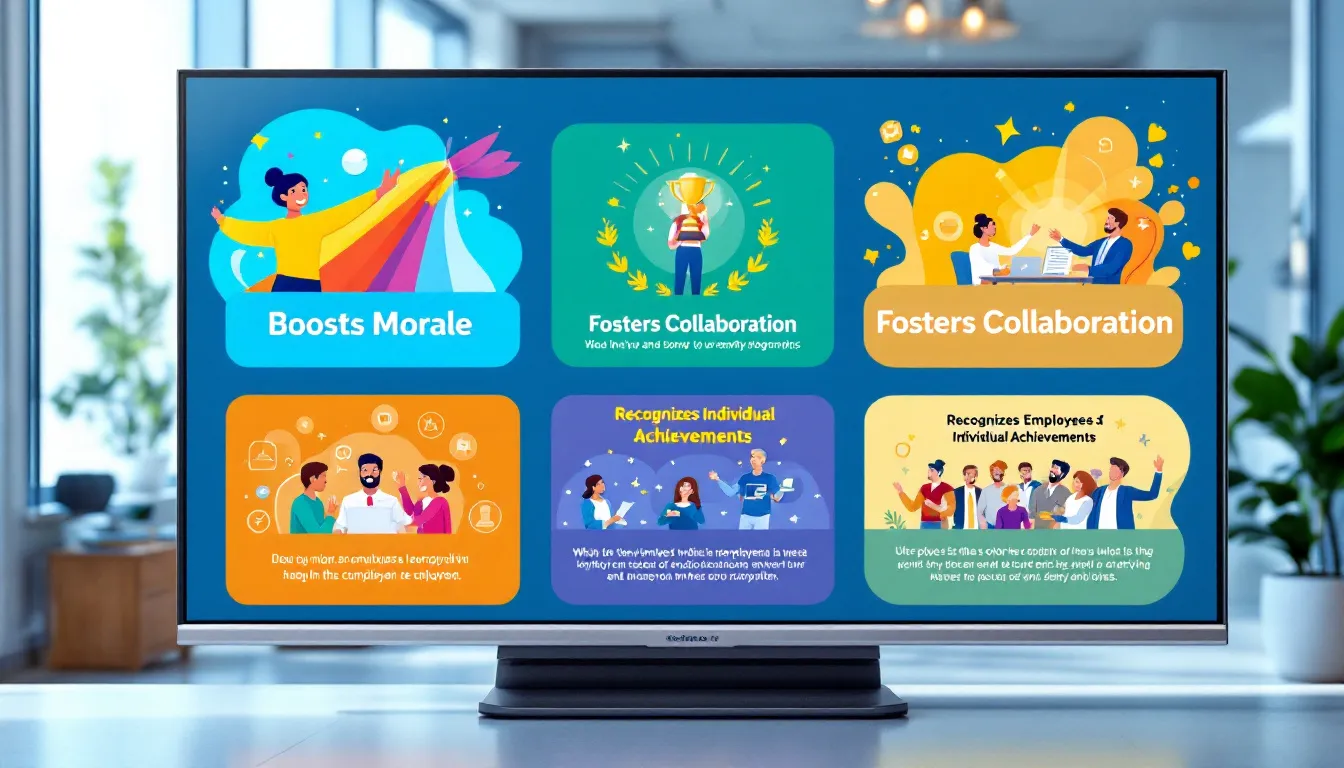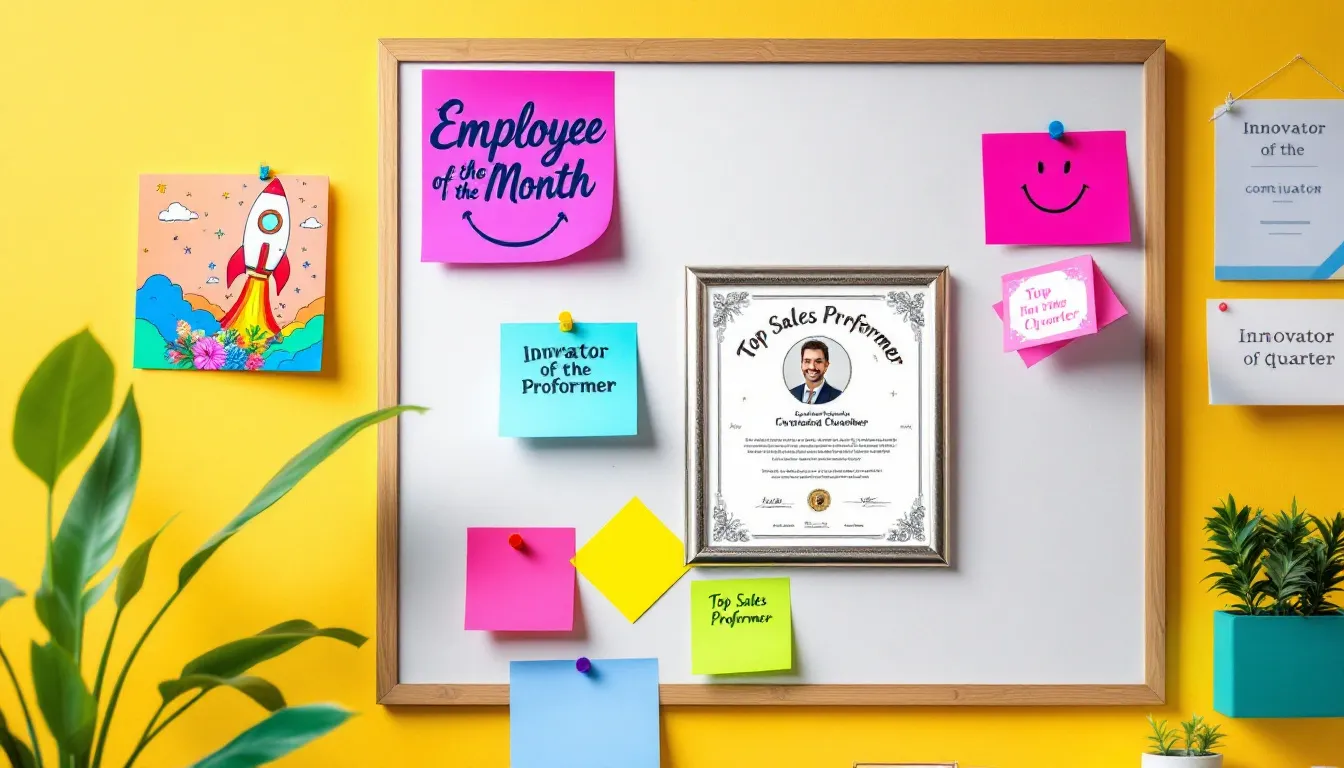Top Strategies for Effective Recognition for Employees

Recognition for employees boosts morale, productivity, and retention. This article explores why it’s essential and how you can implement it effectively.
Key Takeaways
- Effective employee recognition fosters a positive workplace culture and enhances engagement, satisfaction, and retention rates.
- Organizations should implement various recognition methods, including personalized and timely acknowledgments, to cater to individual employee preferences.
- Leveraging technology and innovative ideas in recognition programs can significantly improve employee motivation and overall organizational success.
Understanding Employee Recognition

Employee recognition involves acknowledging and rewarding employees for their contributions and achievements. This practice fosters a positive workplace culture where employees feel valued. Recognition can range from:
- verbal praise
- written notes
- public acknowledgments
- tangible rewards
Recognizing employees fosters a culture of appreciation, enhancing engagement, satisfaction, and productivity. Encouraging employees encourages employees who are acknowledged are more likely to stay motivated, contribute more, and recognize workers loyal to the organization. When employees feel appreciated, they are more inclined to remain committed to their roles.
Recognition falls into three categories:
- Formal recognition, which includes structured programs like awards and ceremonies
- Informal recognition, which involves spontaneous thank-you notes or social media shoutouts
- Everyday recognition, which involves regular feedback and appreciation, including recognition examples.
Defining Employee Recognition
Employee recognition involves acknowledging and rewarding employees for their contributions. Various methods include verbal praise, social media shoutouts, and tangible rewards. Employee recognition strategies such as personalized notes and thank-you messages are especially effective in ensuring team members feel acknowledged and inspired.
Employees have different preferences for recognition. Some value written praise, like thank-you notes or personalized messages, while others appreciate public recognition or tangible rewards. The key is to tailor recognition to individual preferences, ensuring it is meaningful.
Why Employee Recognition Matters
Employee recognition is central to company culture. It boosts morale and engagement, making employees feel valued. Regular employee recognition improves retention rates by reducing turnover.
Consistent recognition for hard work strengthens employees’ connection to their organization and role, boosting loyalty and commitment. A culture of recognition fosters greater satisfaction and a celebrated workplace.
Regular recognition improves team productivity and the entire team morale. Understanding how their work fits into the big picture makes employees more motivated and engaged, leading to a positive attitude, a positive work environment, and thriving company culture.
Key Benefits of Employee Recognition Programs

Employee recognition programs offer numerous benefits that can significantly impact an organization’s success. Recognition enhances engagement, satisfaction, and productivity within companies. A well-implemented recognition program creates a culture of appreciation that boosts overall employee experience.
Consistent recognition programs improve morale, productivity, and job satisfaction. Organizations that prioritize recognition often see significant improvements in workplace culture and team dynamics.
Enhanced Employee Engagement
Enhanced engagement is a key benefit of employee recognition. Recognizing contributions boosts morale and enhances the overall employee experience, leading to greater employee satisfaction. Employees report higher improving employee engagement with consistent recognition for their efforts.
Public recognition via social media or company platforms enhances employee bonding and fosters a sense of community. For instance, DHL’s recognition program with tiered awards and annual events has significantly boosted morale and camaraderie.
Organizations like Hilton, where 95% of employees praise its recognition practices, demonstrate the impact of celebrating contributions. Recognizing committed employees inspires similar behaviors, fostering a culture of excellence and high performance.
Improved Retention Rates
Regular recognition is crucial for retaining top talent, making employees feel valued. Frequent recognition shows the organization’s investment in their career growth, enhancing their intent to stay.
Effective recognition can reduce turnover by up to 31%, significantly impacting retention rates. Companies with strong recognition practices often see lower turnover and higher employee loyalty, making recognition key to retaining top talent.
Increased Productivity
Recognition enhances performance and increases employees’ willingness to contribute more. Organizations with recognition programs are 12 times more likely to achieve strong business outcomes.
Employee recognition can be verbal or written praise, social media posts, or tangible rewards. These motivate employees to maintain high performance and contribute to employee motivation and organizational success.
Types of Employee Recognition

Employee recognition varies, each with unique benefits. It can be:
- Public or private
- Peer-to-peer
- Structured
- Milestone-based
- Team-oriented
Understanding these types helps tailor recognition programs to employees’ preferences and needs.
Simple methods like verbal praise effectively recognize efforts, while written messages or actions can also be impactful. Service awards and company values awards are examples of structured recognition acknowledging loyalty, longevity, and outstanding performance, which demonstrates exceptional performance.
Peer-to-Peer Recognition
Peer-to-peer recognition enhances team cohesion and builds individual confidence. Colleagues showing appreciation for each other’s contributions creates a supportive atmosphere, fostering community, camaraderie, and collaboration.
Recognition from peers offers insights into employee morale and effort that superiors might miss, as well as perspectives from other employees. Systems for positive feedback can encourage ongoing recognition, highlighting everyday achievements and collaborations that might otherwise go unnoticed.
Manager-to-Employee Recognition
Recognition from managers signals that contributions are valued. Specific and detailed praise from leaders increases the effectiveness of verbal recognition, motivating employees seeking promotion by reassuring them that decision-makers acknowledge their efforts.
Effective coaching from managers fosters growth and development, enhancing the impact of recognition. Appreciation from managers boosts employees’ morale and commitment to the organization.
Public vs. Private Recognition
Public recognition significantly influences engagement and is often preferred by many employees. However, personal recognition can be more impactful for those who prefer personalized acknowledgment.
Both forms of recognition are essential, each offering unique advantages for creating a culture of appreciation.
Creating an Effective Employee Recognition Program

An effective employee recognition program involves diverse rewards, tailored recognition, and career development opportunities. Leadership supports models recognition practices, influencing culture and metrics. Regular employee feedback helps refine the program effectiveness, ensuring it meets their needs.
Modern recognition strategies should innovate by considering technology and unique employee achievements to enhance appreciation. This approach creates a more engaging and motivating environment for employees.
Aligning with Company Values
Recognition should reflect organizational values, reinforcing desired behaviors. Effective recognition motivates employees to embody the company’s mission. For instance, Heineken’s renewed recognition strategy features multiple award levels aligned with company values to enhance engagement.
Awards that reflect company values and a commitment to continuous improvement help stabilize teams during challenging times by making employees feel recognized, supported, and valued. This alignment fosters a positive workplace culture where employees feel valued and motivated to contribute to success.
Timely and Specific Recognition
Timely recognition makes acknowledgment meaningful recognition and not perceived as obligatory. Authentic real-time recognition strengthens connections and enhances its impact.
Specific recognition helps employees understand which behaviors are appreciated. Providing context, such as linking it to a larger goal or business outcome, maximizes its impact. Effective recognition should be integrated into daily workflows to ensure frequent acknowledgment.
Inclusive and Fair Practices
Inclusive recognition practices strengthen the perception that all employees are valued. Catering to diverse cultural backgrounds is critical, ensuring every employee feels appreciated for their contributions.
Innovative Ideas for Recognizing Employees
Innovative recognition ideas enhance the impact of appreciation programs. Personalized acknowledgment, informal recognitions like surprise lunches, and experiential rewards are effective strategies for recognizing employees.
Offsite organizes personalized retreats, allowing employees to engage in meaningful experiences that inspire employees through appreciation and recognition. These innovative ideas celebrate individual achievements and contribute to a culture of appreciation and motivation.
Personalized Gifts and Awards
Personalized gifts enhance recognition, making employees feel valued. Corporate gifting companies can help curate gifts that resonate with employees’ preferences and interests.
Customized plaques and testimonials for service awards make recognition more meaningful, fostering a culture of appreciation and improving overall morale and engagement.
Experiential Rewards
Experiential rewards like flying lessons or wine tasting tours provide memorable experiences that surpass standard gifts. These rewards create lasting memories and show genuine appreciation for employees’ contributions.
Professional Development Opportunities
Offering stipends for education or professional certifications shows commitment to employees’ career growth. Professional development opportunities serve as recognition, demonstrating that the organization values employees’ growth and skills.
Leveraging Technology for Employee Recognition
Technology enhances employee recognition. Effective recognition platforms should be interactive and engaging, simplifying the process for organizations. Points-based reward systems allow employees to earn points for their contributions, redeemable for rewards.
Tools like pulse surveys and workplace chatbots can create an agile feedback loop to enhance recognition efforts. By leveraging technology, organizations can ensure that recognition is consistent and meaningful.
Employee Recognition Software
Employee recognition software facilitates consistent, personalized appreciation. User-friendly software enhances the ease of using recognition tools, making it simple for managers and peers to acknowledge efforts. Platforms like eCardWidget streamline the recognition process with personalized messages, ensuring employees feel valued.
Culture Cloud by O.C. Tanner combines written praise, tangible rewards, and public/private recognition features to create a comprehensive recognition experience. Managers are notified through automated email, Slack, and other app alerts when employees are recognized, ensuring timely acknowledgment.
Social Media and Internal Platforms
Social media platforms are powerful tools for sharing and celebrating employee achievements publicly, fostering a sense of community and support. Internal platforms allow for immediate recognition and appreciation of employees’ efforts, creating a culture of acknowledgment within the organization.
Integrating social media with internal recognition helps amplify messages, leading to higher visibility of employee accomplishments within and outside the organization.
Data and Analytics
Utilizing analytics can help identify which core values are being recognized most frequently within teams. This data can provide valuable insights into participation trends and ensure that recognition efforts are aligned with organizational goals.
By leveraging data and analytics, organizations can continuously improve their recognition programs and ensure they are meeting the needs of their employees.
Real-Life Examples of Successful Employee Recognition

Successful employee recognition programs significantly enhance organizational culture by making employees feel valued and appreciated. Companies like Heineken, Chelsea Groton Bank, and Southwest Airlines have demonstrated the power of effective recognition through their innovative programs.
Cisco’s Connected Recognition program allocates 1% of payroll to employee rewards, showcasing their commitment to recognizing employee contributions. Unilever’s Heroes Award celebrates those who contribute significantly to the company each year, fostering a culture of appreciation and motivation.
Offsite's Approach to Recognition
Offsite helps companies celebrate their employees in meaningful ways by curating experiences that spotlight achievements and foster a culture of appreciation. Their approach makes recognition part of a team’s DNA, offering staff recognition moments and full-scale employee appreciation retreats.
Global Companies Leading the Way
Zappos integrates appreciation into its culture, leading to exceptional customer service, as employees go the extra mile when they feel valued. Companies that prioritize recognition, like Zappos, experience improved employee morale and engagement, impacting their overall success and customer satisfaction.
These global organizations create an example by demonstrating how effective recognition strategies can drive organizational success and create a positive workplace culture. Their commitment to recognizing employee contributions has led to higher engagement, satisfaction, and retention, showcasing various employee recognition examples and success stories.
Summary
Employee recognition is a vital component of any successful organization. It enhances employee engagement, boosts morale, reduces turnover, and increases productivity. By implementing effective recognition programs, aligning with company values, and leveraging technology, organizations can create a culture of appreciation that motivates and inspires employees. Start recognizing your employees today and watch your workplace transform into a hub of positivity and productivity.
FAQs
- What are some types of employee recognition?
Employee recognition can take various forms, including public or private acknowledgments, peer-to-peer recognition, structured programs, milestone celebrations, and team-oriented rewards. Each type plays a vital role in fostering a positive work environment.
- How does employee recognition improve retention rates?
Employee recognition significantly improves retention rates by making employees feel valued and appreciated, fostering loyalty and reducing turnover. This creates a more committed workforce.
- What role does technology play in employee recognition?
Technology plays a crucial role in employee recognition by enabling consistent and personalized acknowledgment through platforms that seamlessly integrate with daily workflows, providing real-time feedback. This helps foster a culture of appreciation and enhances overall employee engagement.
- What are some innovative ideas for recognizing employees?
Recognizing employees through personalized gifts, experiential rewards, and opportunities for professional development can significantly enhance engagement and motivation. Implementing these strategies can create a more positive work environment.
You may also like
Unique spaces for your next offsite
Find distinctive venues for your upcoming corporate retreat.
Stay Updated with Our Insights
Get exclusive content and valuable updates directly to you.







